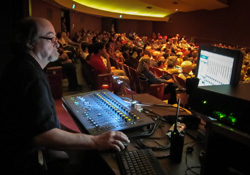
Founded in 1972, the Stanford Jazz Workshop has been nurturing talent for over 40 years, bringing in some of the world’s greatest artists to mingle with students of the Jazz Camp by day, followed by performances at the Stanford Jazz Festival by night.
Countless jazz greats have participated over the years, and this year was no exception, with Herbie Hancock, Dr. Lonnie Smith, and Stanley Clarke just a few of the highlights of the nonprofit organization’s 42nd season.
Most of this year’s performances were held in Stanford’s Dinkelspiel Auditorium, with Bay Area live sound veteran Lee Brenkman taking on sound reinforcement responsibilities again. Brenkman, who has been associated with the Jazz Festival for over a decade, also heads up sound at two iconic San Francisco clubs—The Great American Music Hall and Slim’s.
This year, although he faced many of the same unique challenges that plague the festival, Brenkman found a new solution that provided the workflows and sound quality he needed.
“One thing about the Stanford Jazz Festival,” he explains, “is that time is short. Even though there’s usually just one band per concert, they use the stage of the venue as a classroom until 5 pm, which means that between 5 pm and 6:30 pm, we have to turn it around into a performance space again.”
A longtime user of Avid live systems at the two clubs, Brenkman chose the new Avid S3L for this year’s festival, as the modular, networked system enabled a simplified setup with the best possible sound quality.
“All the festival techs were really fascinated with the system, really liking the size, the Cat-5 snake—all the things that make setting up and tearing down a system a drag,” he says. “We ran a couple of runs of Cat-5 and were able to keep the snake in place, just striking the stage boxes at the end of the night to get them out of the way of the classroom kids. Just changing out our usual console for this was an enormous improvement in sound quality—it was really audible. Everybody agreed that it just sounded noticeably better.”
As the primary sound engineer for the festival, Brenkman strategically used the layers of S3L’s compact surface to handle a variety of mixing tasks.
“I mix the for the house, I mix the monitors, and I’m doing a completely separate mix for the recording, because at Dinkelspiel [Auditorium], for example, the amount of trap drums I need on the recording is much more than what I need in the auditorium,” he explains. “So what I did is assign all the head amps to two layers. The top layer of 16 [channels] was for the PA, and then I could switch to [channels] 17–32, and those were my recording mix. On average, I was doing four monitor mixes, and in some cases, six. I did not feel at any time that the console was too complicated to grab at something fast.”
The S3L’s integrated recording features matched up well to Brenkman’s other responsibility at the festival—capturing the performances of the jazz legends each night.
“Part of the job is to do archival recording of every concert, and just coincidentally, the Stanford [University] Archive of Recorded Sound, which is where [the files] all eventually go, their preferred format for live performances is 24-bit, 48 kHz WAV files. Well guess what? I’ve got a USB key that I can [plug directly into the S3L System and create recordings] that I dump onto a hard drive at the end of the season and hand to them. God it’s an incredibly capable little system.”
